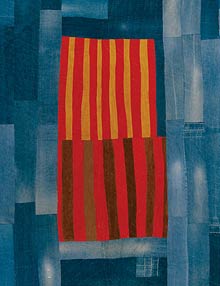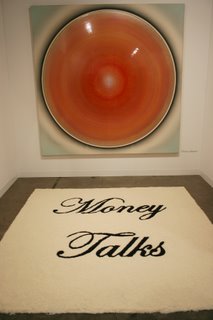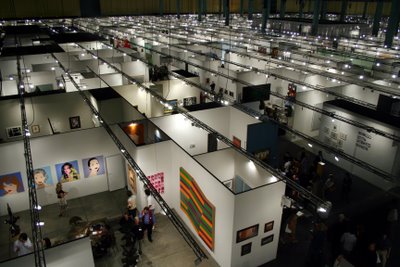Probably enough has been said about the quilts already, and anyone with half a finger on the pulse of the art world knows about it. The press release says, "Organized by the Museum of Fine Arts, Houston, with the Tinwood Alliance, Atlanta, the exhibition has been on a three-year, coast-to-coast, twelve-venue tour since its premiere in Houston in the fall of 2003." I saw the show at the de Young a few weeks ago. It closes today. I believe this the final venue. I have to thank Mel Prest for mentioning it to me several times.
Now, here are some people who I would think have good reason to complain about their day jobs. Farmers and fieldworkers, raising families in poverty, geographically cut off from opportunity and resources- who has time to be creative? And yet their faith in family, God, hard work, and consistent and continual making resulted in beautiful and very moving objects that have shifted from functional bedcovers to concrete, visual, transcendent objects that are innovative testaments to the handmade and communal.
 I found this show tremendously moving, not only because of the circumstances in which they were made. For a museum exhibition, it's not enough to be moved by these circumstances. Certainly, art objects made in a difficult situation can tell us valuable things about the people and their times, but for the object to be aesthetically powerful requires something more. And it seems the women of Gee's Bend found that.
I found this show tremendously moving, not only because of the circumstances in which they were made. For a museum exhibition, it's not enough to be moved by these circumstances. Certainly, art objects made in a difficult situation can tell us valuable things about the people and their times, but for the object to be aesthetically powerful requires something more. And it seems the women of Gee's Bend found that.Of course, I was moved by the story of how these quilts were made, and I was especially moved that the quilts are made in spite of a day's work, often in the company of others. I found it especially interesting that a functional product- something so functional in the circumstances in which it was used that it could even barely be called craft- which implies hobby and decoration- could be elevated to art object. This is part of what I found both humbling and inspiring.
But there's more. These quilts are truly handmade- hand cut, handstitched- and while many utilize various traditional patterns, these often have little twists and interruptions in them, while many others eschew pattern and have a feel of improvised compostion, more modern collage than historical symmetric structure. Up close you can see the stitches, the fabric frayed by washing and use. But stand back, and they feel composed by a commanding and experienced eye capable of setting up rhythm and contrast, tension and surprise.
I often read press releases for exhibitions in which So-and-so's art plays with some crap notion of this assumption or that received idea or another that questions and challenges our assumptions about this or that miniscule thing that results in a paradigm shift to some other imagined nothing. Geez, they're pretentious and cliched at the same time.
But in the Gee's Bend show here are some genuine questions about where art comes from, how it's made and for whom, who makes it, art's origins and place in daily life. That's powerful stuff, and there is a real challenge to our assumptions. This show does it in broad daylight with no theoretical sleight of hand, and with a mimimum of contextual and historical knowledge required. It's just so plainly and visibly beautiful and bold. It makes me want to say lame predictable things like "celebration of the spirit," and "triumph over adversity."
It's too obvious a connection to talk about the quilts in relation to geometric abstraction- they're just different animals with a different purpose. In fact, I think it's a waste of time to make a competition between the quilts and painting. They are about different things, and anyone with a pair of eyes knows that immediately. I see these as closest to Korean wrapping cloths called bojagi, which are also made using fabric scraps.
The closest art connection I keep making is to Rauschenberg, and his reuse of materials, especially fabric. Compostionally, feeling-wise, there seems to be something shared in how things are arranged, a sensitivity to color and pattern, to the use of found materials. I'm thinking not only of Rauschbenerg's combines, but also his cardboard pieces.
But even still, this is a fruitless comparison. I really brought up Rauschenberg to make another point. There is his famous quote, "Painting relates to both art and life. Neither can be made. (I try to act in that gap between the two.)" I think that for the Gee's Bend quilters that gap doesn't exist at all. There is no split. The quilts and their making are part of a greater whole- the lives of their makers. This seems unusual to me these days. It is especially unusual for art, which often seems disconnected from life's dailyness. Partly, it is unique, I think, because of the medium itself- fabric and thread, which are ordinary and domestic materials that anyone is familiar with- and because these quilts are originally functional objects; most contemorary art does not have these origins. The quilts were intended to be part of everyday life. The quilters and their families are the primary, original audience, and the primary users. There seems to be no gap between the maker, the intended object and its use, and people who use it. This wholeness is also unique because these quilters defied tradition by not settling into historical patterns, but instead used their eyes to compose and make, working by hand and responding immediately to their materials, learning from and working in the company of each other, day after day over the years. It's remarkable to see how these objects, made for a specific use in a particular place, can now function as powerful art objects for a much larger, more diverse audience.


